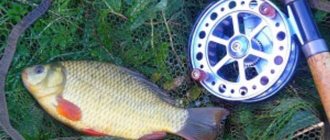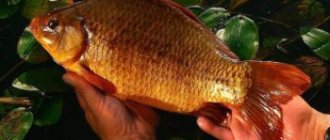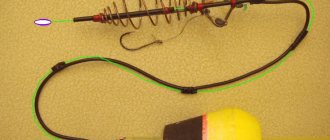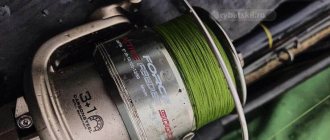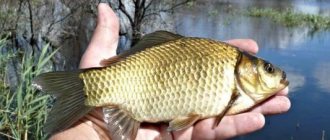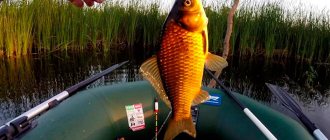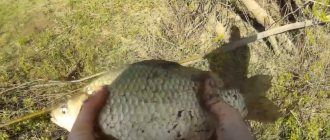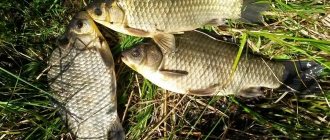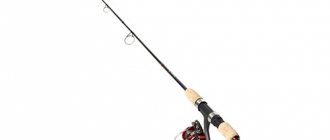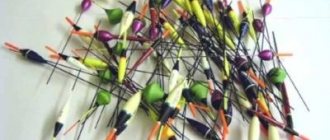May is one of the most favorable months for catching carp, since it is then that this fish begins to swim more towards the shore to feed itself. This article will discuss in detail what is the best way to catch carp in May, what baits and baits to use, what flavors to add and much more.
What kind of bait should be used to catch carp in May?
To lure carp to the desired place on the pond and keep it there for as long as possible, you should always use high-quality bait. There is no need to be afraid that you will overfeed the carp and it will no longer want to bite the bait, since this is simply impossible.
On the day before fishing, you need to throw bait into the water sparingly, the total weight of which should be at least ten kilograms.
The best baits for carp are:
- Sunflower seed cake.
- Semolina or mash, which is boiled or infused in water until it forms a doughy mass.
- Millet dough, which must first be boiled and then baked in the oven for 3-4 hours.
- Pearl barley porridge, which should be cooked for no more than forty-five minutes.
- Corn (you can use either store-bought or home-cooked corn, but the latter is usually not very practical).
In May, the following additives are usually mixed into the bait:
- bloodworm;
- bloodworm;
- boilie;
- cereals;
- porridge (barley, buckwheat, rolled oats, millet);
- mashed potatoes;
- purchased bait mixtures.
Homemade bait recipes
There are many ways to prepare homemade bait. Each fisherman prepares bait based on his preferences.
To create good bait, you need to know a couple of good recipes. We will indicate some recipes for feeding crucian carp.
Recipe No. 1
Ingredients:
- Millet 200 grams;
- Semolina 100 kg;
- Barley 100 grams;
- Breadcrumbs 1 pack;
- Cake.
Preparation:
- Cook the millet over low heat.
- After the millet has boiled for 10 minutes, add semolina and stir constantly to avoid burning.
- Add pearl barley and continue cooking for another 20 minutes.
- Drain excess water from the pan and cook for another 30 minutes.
- Turn off the heat, pass the resulting porridge through a sieve and cool.
- When the porridge has cooled, add breadcrumbs. And to increase the smell, add poppy seeds.
Recipe No. 2
Ingredients:
- Pearl barley 0.5 kg;
- Peas 100 grams;
- Millet porridge 0.5 kg;
- Any flavoring.
Preparation:
- Place the pearl barley porridge on the fire and stir constantly to prevent burning.
- When the pearl barley boils, wait 10 minutes and add millet porridge, peas and cook until tender.
- We wait for the porridge to steam and drain the water.
- At the end, add any flavoring, for example, ground garlic. Just don't overdo it. You don't need to add too much of it.
Recipe No. 3
Ingredients:
- Millet 200 grams;
- Yachka 200 grams;
- Ground corn 100 grams;
- Semolina 100 grams;
- Cake.
Preparation:
- Mix all ingredients with water from a pond. At the end, sprinkle with flour.
- It is important that the bait is thick. This is an important condition, thanks to it the bait will be able to fall to the bottom of the reservoir and attract larger fish.
How to feed carp in May?
Carp can be fed in two ways:
- Feed fish in a specific area of the reservoir. To do this, you need to scatter the bait exactly at the point where you want to catch carp.
- Feed fish throughout the entire area. To do this, you need to scatter complementary food around the pond, but this method is less effective because it will not be able to keep the fish in one place for a long time.
Tips for properly catching carp and using complementary foods:
- the bait must be thrown not only before the day of fishing, but also in the morning on the day when fishing takes place;
- carp are most active before dawn, this must be taken into account when fishing;
- the total weight of bait for the entire fishing period should be at least fifteen kilograms.
Flavoring of bait and dip
To catch carp, you cannot do without flavorings, which must be added to the finished bait and groundbait.
To correctly select and apply a flavoring agent, experts advise using the following recommendations:
- In May, it is better to use natural scents for the bait mixture, rather than store-bought artificial flavors that are made from chemicals. This is due to the fact that in the spring natural aromas predominate, and if you use too strong odors, then a carp that is not used to it may get scared of them and not swim in the bait at all.
- If the fisherman has no desire to tinker with natural flavors, then it is better to use alcohol-based or molasses-based additives.
- It is necessary to add to the mass of complementary foods the ingredient that you will later use as a bait.
There is a classic list of flavorings to which a gourmet like carp responds well:
- purchased dips that are ready for use and do not require additional preparation;
- chocolate powders;
- vanilla;
- garlic juice;
- honey;
- ground seeds;
- anise oil;
- chalked cinnamon;
- purchased additives in the form of flavorings in granules or powder with a wide variety of odors;
- crushed cereal.
What should be the bait for carp fishing in May?
Carp is a fish that eats a wide variety of foods, but still there are some ingredients that this fish bites on most often.
Such baits include the following elements:
- A crumb of white bread from which small peas are rolled.
- Corn.
- Peas.
- Potatoes (necessarily half-raw, since carp will not take boiled potatoes).
- Boilies.
- The dough is steep with added flavors.
- Red earthworms.
- Maggots (the second favorite dish of carp after corn).
- 9. Semolina chatter.
In addition, these attachments can be combined on one hook. This way you can attract more attention from the fish and this will give you a better chance of a good bite.
Tips for the correct selection and use of nozzles:
- in each pond, a carp can bite on a different bait, so if on one pond it bites well on corn, this does not mean that on another pond it will also prefer it to all other baits;
- It is desirable that the bait be very soft - this will significantly improve the bite;
- at low temperatures, carp bite more on bait of animal origin (worms), and at high temperatures - on vegetable bait (porridge, peas, corn, etc.);
- it is necessary to introduce a new flavor into the bait in small quantities so that the unusual smell does not scare off the carp;
- for the production of complementary foods and baits, it is advisable to use water from ponds or rainwater, rather than city chlorinated water;
- all ingredients included in baits or complementary foods must always be fresh, free from contamination in the form of bugs or debris and have a pleasant smell;
- It is advisable to use ceramic dishes for attachments.
Vegetable baits
In summer, it is advisable to catch carp using vegetable baits or artificial baits with flavors - boilies. In warm weather, anglers most often choose young corn as bait, fresh, boiled or canned. But carp can also be attracted by several grains of wheat, young peas, pearl barley and oatmeal on a hook. Hard grains need to be boiled or steamed - this way they acquire the softness necessary for planting.
Corn
The most popular bait for carp is corn. It is suitable for catching both large and small specimens. The choice of equipment when using corn is predetermining; you can use hair, method, float, Bolognese and others. How to properly plant young corn on carp is a controversial issue; there are several methods.
When using hair rigs to catch large carp, it is advisable to use several corns as bait. In this case, even if a small fish eats 1-2 seeds, the large carp will get the bulk of the bait.
When fishing for carp in April, May and June, it makes sense to use not only corn as bait, but also several live fly larvae - maggots. Firstly, this bright bait will attract even picky fish, and secondly, it can tempt both herbivorous and “predatory” carp to bite, which is especially important when fishing during the transition period. The disadvantage of such equipment and bait is that small fish - roach, crucian carp, rotan - can quickly peck at it.
When fishing with float gear, corn can be hooked directly onto the hook, without the use of hair equipment. You can also use boiled and young peas, pearl barley, wheat and other vegetable baits along with corn seeds.
Peas
On some reservoirs, fishermen noticed that large carp bite better on peas. As in the case of corn and boilies, it is better to place it on a hair rig in the amount of 2-4 pieces. In fishing stores you can find both corn and peas with various flavors. But in order to save money, you can prepare pea seeds yourself or buy canned peas; fresh, young peas are also suitable for carp. Its use as bait is similar to that of corn.
Pearl barley
All carp fish species like pearl barley
Pearl barley porridge is usually used when fishing for crucian carp, but if you add flavorings to it during cooking, you can also attract carp with this bait. According to the observations of fishermen, carp readily take pearl barley if it is used together with maggot, corn, peas or boilies.
Potato
The potato cube is an effective bait for catching carp in all fishing games - this is true
Potato cubes or lump potatoes for carp are used by many professional fishermen. This root vegetable is suitable in any form: raw, fried, boiled, with or without flavorings. At the same time, as is the case with other baits, when catching carp with potatoes, it is also advisable to use a hair rig - this way you can cut off small fish, such as crucian carp and roach, which are also often tempted by potatoes. Natural baits are a great way to go carp fishing without buying expensive boilies - but not always effective when trying to catch trophy carp.
Semolina and dough
In conditions where there are no small fish in the reservoir, or they feed only near the surface, it makes sense to catch carp using semolina and dough, the main thing is to prepare them correctly. If there is a lot of small stuff in the pond, then the semolina will not have time to attract cyprinids and will quickly be eaten before it reaches the bottom. Semolina and dough are very effective when catching crucian carp, especially with a “crucian carp killer” tackle with a spring feeder.
What to use to catch carp at the end of May?
At the end of May, when the water has already warmed up significantly and it’s heading towards summer, the taste preferences of carp may change slightly.
The following ingredients can be used as attachments:
- boiled or jarred corn (pickled);
- boiled or pickled peas;
- pearl barley.
But in this case, the nozzle itself is not enough. It is imperative to add flavorings or flavoring additives to the container with the finished bait, which will give the bait an even more attractive smell.
The main requirement that any flavoring must meet is to have a natural, non-pungent odor. At the end of May, it is better to opt for sweet smells (honey, vanilla) or sea (shrimp, crab).
Fishing tactics
As you know, carp is a very timid fish, and the older it gets, the more careful it behaves.
In order to have a chance to catch a particularly large specimen, you need to choose the right not only the fishing location, bait and bait, but also behave as quietly and inconspicuously as possible.
Carp fishing tactics include the following features:
- When fishing, it is recommended that the fisherman wear special clothing that will blend in with the environment so that the carp cannot notice too bright colors and consider them dangerous. It is advisable that clothes be in green or brown shades.
- You need to be as quiet as possible when fishing for carp. Even the slightest noises or screams can significantly affect the entire fishing process.
- It is more effective to put the bait not on the hook itself, but on a special hair, which is made from mono fishing line and is pulled through the bait.
- The carp does not immediately swallow the bait, but rather tastes and sucks it for some time. With this he can make light bites, but there is no need to rush to hook him, otherwise he may break loose. You should wait until the float completely sinks in the water and only then hook.
- Since carp is a fairly large and strong fish, you need to pull it out very carefully and deftly, otherwise you can lose not only your catch, but also your fishing line and rod, which the carp can break with its jerks.
If you adhere to all the above recommendations, your chances of catching truly trophy carp will increase significantly.
What bait to use when fishing for crucian carp
A popular bait when fishing for crucian carp is worms. Any kind is suitable, rain, dung, California, although depending on the body of water, the fish may have their own preferences.
When fishing in spring and autumn, the worm is the main bait, but the mood of crucian carp is changeable and it happens that it can suddenly stop pecking at it. Bites may become rare or stop altogether, the reason for this is not known.
At such times, you should try other types of bait.
In the spring, if the bite on the worm has stopped, a replacement can be bloodworms, maggots or caddisfly larvae, served to the crucian carp in the form of a large bunch, you can try vegetable bait.
When catching large crucian carp, the only bait is bunches of dung worms.
In summer, plant baits can give good results. The following plant baits give results:
- mastyrka made from peas or semolina, breadcrumbs;
- steamed barley;
- bread paste, including sweet;
- corn;
- peas;
- pelets, but it’s difficult to find the right one.
If there are interruptions when biting the worm, try the so-called sandwiches, try, for example, putting a worm and barley grain on a hook. It's important to experiment.
